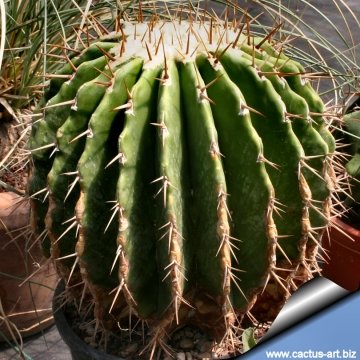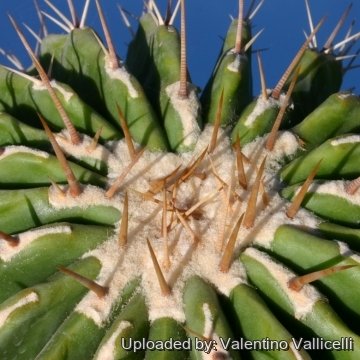Donate now to support the LLIFLE projects.
Your support is critical to our success.
Your support is critical to our success.
= Echinocactus platyacanthus var. viznaga (Hook.) W.T.Marshall
Accepted Scientific Name: Echinocactus platyacanthus Link & Otto
Verh. Vereins Beford. Gartenbaues Konigl. Preuss. Staaten 3: 423. T. 14. 1826 (1827)

Echinocactus ingens f. viznaga (Echinocactus platyacanthus var. viznaga) Photo by: Valentino Vallicelli
Synonyms:
- Echinocactus platyacanthus var. viznaga (Hook.) W.T.Marshall
- Echinocactus ingens f. viznaga (Hook.) Voss in Vilm.
- Echinocactus viznaga Hook.
See all synonyms of Echinocactus platyacanthus
back
Accepted name in llifle Database:Echinocactus platyacanthus Link & Otto
Verh. Vereins Beford. Gartenbaues Konigl. Preuss. Staaten 3: 423. T. 14. 1826 (1827)
Synonymy: 22
- Echinocactus platyacanthus Link & Otto
- Echinocactus ingens Zucc. ex Pfeiff.
- Echinocactus ingens f. aulocogonus (Lem.) Schelle
- Echinocactus ingens var. helophorus (Lem.) K.Schum.
- Echinocactus helophorus Lem.
- Echinocactus ingens f. helophorus (Lem.) Schelle
- Echinocactus ingens var. saltillensis (hort.) K.Schum.
- Echinocactus ingens f. saltillensis (Poselg.) Schelle
- Echinocactus saltillensis hort. non Poselg.
- Echinocactus ingens var. subinermis K.Schum.
- Echinocactus ingens var. viznaga (Hook.) K.Schum.
- Echinocactus karwinskii Zucc. ex Pfeiff.
- Echinocactus platyacanthus f. cristata hort.
- Echinocactus platyacanthus f. grandis (Rose) Bravo
- Echinocactus grandis Rose
- Echinocactus ingens var. grandis (Rose) Krainz
- Echinocactus platyacanthus var. palmeri (Rose) H.P.Kelsey & Dayton
- Echinocactus palmeri Rose
- Echinocactus platyacanthus var. viznaga (Hook.) W.T.Marshall
- Echinocactus ingens f. viznaga (Hook.) Voss in Vilm.
- Echinocactus viznaga Hook.
back

Echinocactus ingens f. viznaga (Echinocactus platyacanthus var. viznaga) Photo by: Cactus Art

Echinocactus ingens f. viznaga (Echinocactus platyacanthus var. viznaga) Photo by: Cactus Art

Echinocactus ingens f. viznaga (Echinocactus platyacanthus var. viznaga) Photo by: Valentino Vallicelli
Send a photo of this plant.
The gallery now contains thousands of pictures, however it is possible to do even more. We are, of course, seeking photos of species not yet shown in the gallery but not only that, we are also looking for better pictures than those already present. Read More...
The gallery now contains thousands of pictures, however it is possible to do even more. We are, of course, seeking photos of species not yet shown in the gallery but not only that, we are also looking for better pictures than those already present. Read More...
| Your Actions | |
|---|---|
| Back to Echinocactus index | |
| Back to Cactaceae index | |
 |
Back to Cacti Encyclopedia index |








